Commentary on Spinal Cord Injury Treatment and Neurotechnology
VerifiedAdded on 2022/11/15
|6
|1216
|386
Report
AI Summary
This report provides a commentary on an article discussing the application of neurotechnology, specifically epidural electrical stimulation (EES), in treating spinal cord injuries (SCI). The article highlights the potential of EES to restore voluntary motor control, including walking, in individuals with severe paralysis. The technology involves implanting a pulse generator to deliver targeted electrical stimulation to the lumbosacral spinal cord, activating motor neurons and proprioceptive circuits. The report explains the mechanisms by which EES enables spatiotemporal control of leg movements, potentially re-establishing cortical control and strengthening motor neurons. The research also suggests the importance of rehabilitation alongside EES treatment. The report emphasizes the potential of EES as a practical technology to improve the lives of individuals with SCI and impaired leg movement. The commentary discusses the study design, results, and implications of EES in restoring motor function in SCI patients, and its significance for human life today.
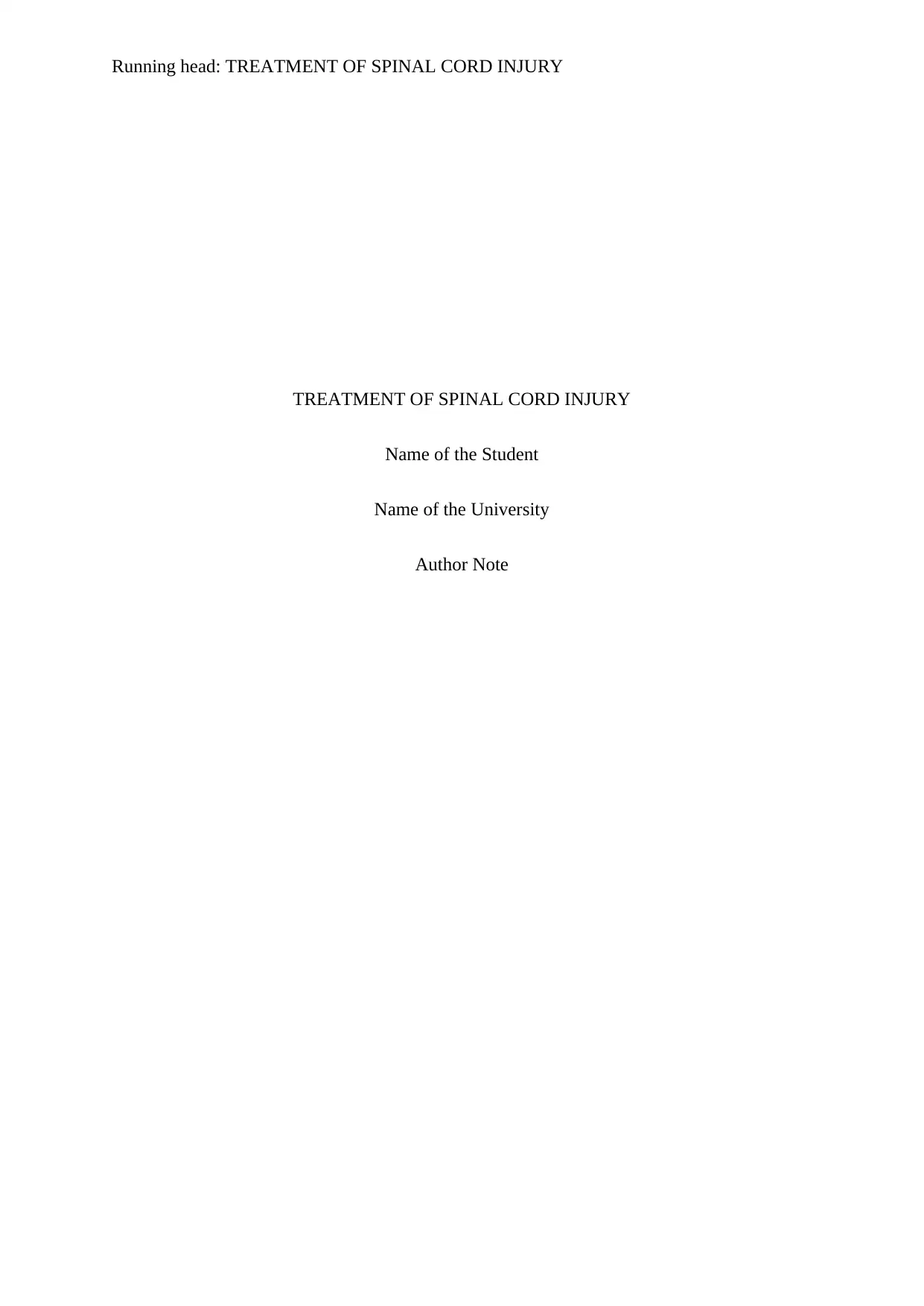
Running head: TREATMENT OF SPINAL CORD INJURY
TREATMENT OF SPINAL CORD INJURY
Name of the Student
Name of the University
Author Note
TREATMENT OF SPINAL CORD INJURY
Name of the Student
Name of the University
Author Note
Paraphrase This Document
Need a fresh take? Get an instant paraphrase of this document with our AI Paraphraser
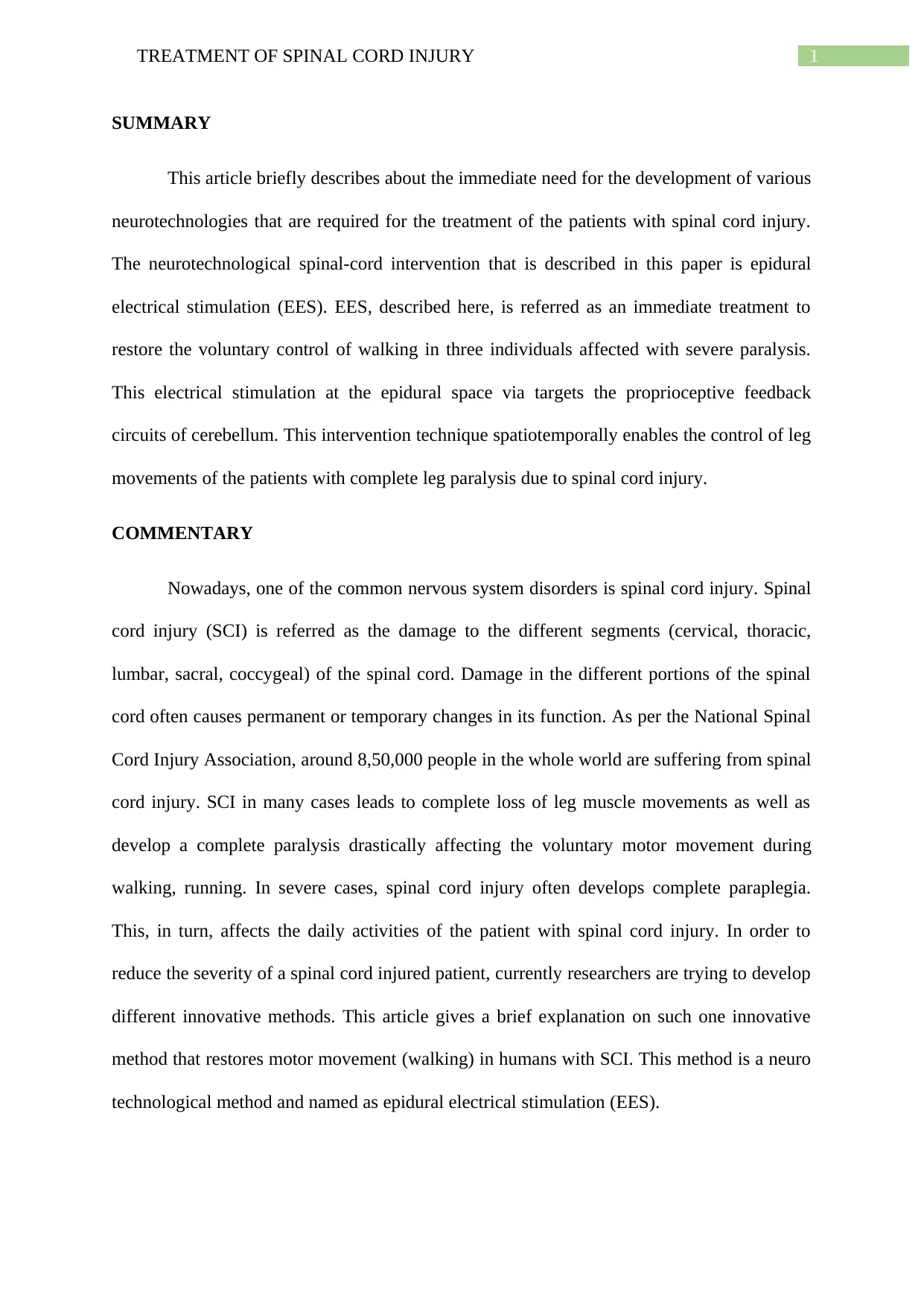
1TREATMENT OF SPINAL CORD INJURY
SUMMARY
This article briefly describes about the immediate need for the development of various
neurotechnologies that are required for the treatment of the patients with spinal cord injury.
The neurotechnological spinal-cord intervention that is described in this paper is epidural
electrical stimulation (EES). EES, described here, is referred as an immediate treatment to
restore the voluntary control of walking in three individuals affected with severe paralysis.
This electrical stimulation at the epidural space via targets the proprioceptive feedback
circuits of cerebellum. This intervention technique spatiotemporally enables the control of leg
movements of the patients with complete leg paralysis due to spinal cord injury.
COMMENTARY
Nowadays, one of the common nervous system disorders is spinal cord injury. Spinal
cord injury (SCI) is referred as the damage to the different segments (cervical, thoracic,
lumbar, sacral, coccygeal) of the spinal cord. Damage in the different portions of the spinal
cord often causes permanent or temporary changes in its function. As per the National Spinal
Cord Injury Association, around 8,50,000 people in the whole world are suffering from spinal
cord injury. SCI in many cases leads to complete loss of leg muscle movements as well as
develop a complete paralysis drastically affecting the voluntary motor movement during
walking, running. In severe cases, spinal cord injury often develops complete paraplegia.
This, in turn, affects the daily activities of the patient with spinal cord injury. In order to
reduce the severity of a spinal cord injured patient, currently researchers are trying to develop
different innovative methods. This article gives a brief explanation on such one innovative
method that restores motor movement (walking) in humans with SCI. This method is a neuro
technological method and named as epidural electrical stimulation (EES).
SUMMARY
This article briefly describes about the immediate need for the development of various
neurotechnologies that are required for the treatment of the patients with spinal cord injury.
The neurotechnological spinal-cord intervention that is described in this paper is epidural
electrical stimulation (EES). EES, described here, is referred as an immediate treatment to
restore the voluntary control of walking in three individuals affected with severe paralysis.
This electrical stimulation at the epidural space via targets the proprioceptive feedback
circuits of cerebellum. This intervention technique spatiotemporally enables the control of leg
movements of the patients with complete leg paralysis due to spinal cord injury.
COMMENTARY
Nowadays, one of the common nervous system disorders is spinal cord injury. Spinal
cord injury (SCI) is referred as the damage to the different segments (cervical, thoracic,
lumbar, sacral, coccygeal) of the spinal cord. Damage in the different portions of the spinal
cord often causes permanent or temporary changes in its function. As per the National Spinal
Cord Injury Association, around 8,50,000 people in the whole world are suffering from spinal
cord injury. SCI in many cases leads to complete loss of leg muscle movements as well as
develop a complete paralysis drastically affecting the voluntary motor movement during
walking, running. In severe cases, spinal cord injury often develops complete paraplegia.
This, in turn, affects the daily activities of the patient with spinal cord injury. In order to
reduce the severity of a spinal cord injured patient, currently researchers are trying to develop
different innovative methods. This article gives a brief explanation on such one innovative
method that restores motor movement (walking) in humans with SCI. This method is a neuro
technological method and named as epidural electrical stimulation (EES).
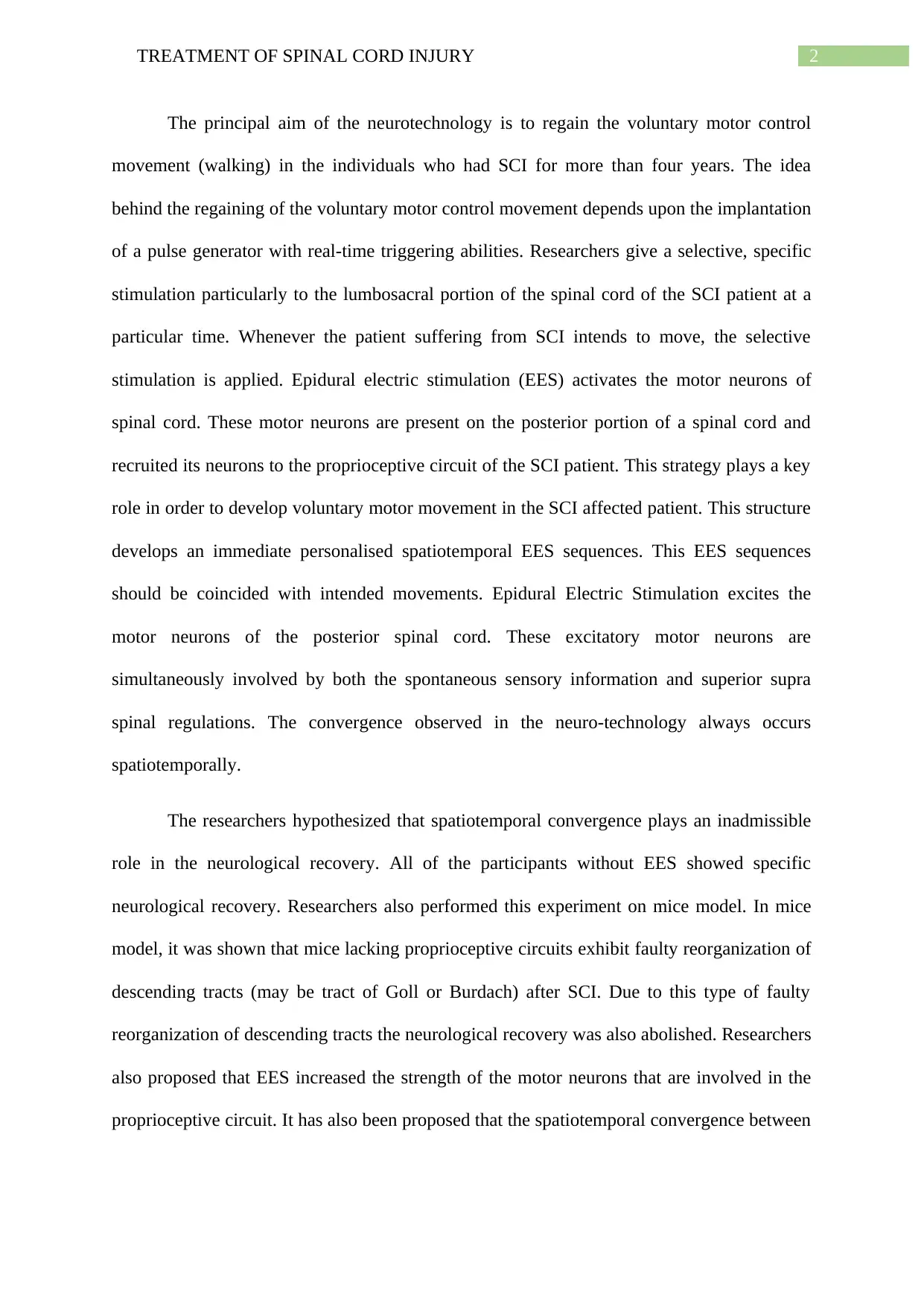
2TREATMENT OF SPINAL CORD INJURY
The principal aim of the neurotechnology is to regain the voluntary motor control
movement (walking) in the individuals who had SCI for more than four years. The idea
behind the regaining of the voluntary motor control movement depends upon the implantation
of a pulse generator with real-time triggering abilities. Researchers give a selective, specific
stimulation particularly to the lumbosacral portion of the spinal cord of the SCI patient at a
particular time. Whenever the patient suffering from SCI intends to move, the selective
stimulation is applied. Epidural electric stimulation (EES) activates the motor neurons of
spinal cord. These motor neurons are present on the posterior portion of a spinal cord and
recruited its neurons to the proprioceptive circuit of the SCI patient. This strategy plays a key
role in order to develop voluntary motor movement in the SCI affected patient. This structure
develops an immediate personalised spatiotemporal EES sequences. This EES sequences
should be coincided with intended movements. Epidural Electric Stimulation excites the
motor neurons of the posterior spinal cord. These excitatory motor neurons are
simultaneously involved by both the spontaneous sensory information and superior supra
spinal regulations. The convergence observed in the neuro-technology always occurs
spatiotemporally.
The researchers hypothesized that spatiotemporal convergence plays an inadmissible
role in the neurological recovery. All of the participants without EES showed specific
neurological recovery. Researchers also performed this experiment on mice model. In mice
model, it was shown that mice lacking proprioceptive circuits exhibit faulty reorganization of
descending tracts (may be tract of Goll or Burdach) after SCI. Due to this type of faulty
reorganization of descending tracts the neurological recovery was also abolished. Researchers
also proposed that EES increased the strength of the motor neurons that are involved in the
proprioceptive circuit. It has also been proposed that the spatiotemporal convergence between
The principal aim of the neurotechnology is to regain the voluntary motor control
movement (walking) in the individuals who had SCI for more than four years. The idea
behind the regaining of the voluntary motor control movement depends upon the implantation
of a pulse generator with real-time triggering abilities. Researchers give a selective, specific
stimulation particularly to the lumbosacral portion of the spinal cord of the SCI patient at a
particular time. Whenever the patient suffering from SCI intends to move, the selective
stimulation is applied. Epidural electric stimulation (EES) activates the motor neurons of
spinal cord. These motor neurons are present on the posterior portion of a spinal cord and
recruited its neurons to the proprioceptive circuit of the SCI patient. This strategy plays a key
role in order to develop voluntary motor movement in the SCI affected patient. This structure
develops an immediate personalised spatiotemporal EES sequences. This EES sequences
should be coincided with intended movements. Epidural Electric Stimulation excites the
motor neurons of the posterior spinal cord. These excitatory motor neurons are
simultaneously involved by both the spontaneous sensory information and superior supra
spinal regulations. The convergence observed in the neuro-technology always occurs
spatiotemporally.
The researchers hypothesized that spatiotemporal convergence plays an inadmissible
role in the neurological recovery. All of the participants without EES showed specific
neurological recovery. Researchers also performed this experiment on mice model. In mice
model, it was shown that mice lacking proprioceptive circuits exhibit faulty reorganization of
descending tracts (may be tract of Goll or Burdach) after SCI. Due to this type of faulty
reorganization of descending tracts the neurological recovery was also abolished. Researchers
also proposed that EES increased the strength of the motor neurons that are involved in the
proprioceptive circuit. It has also been proposed that the spatiotemporal convergence between
⊘ This is a preview!⊘
Do you want full access?
Subscribe today to unlock all pages.

Trusted by 1+ million students worldwide
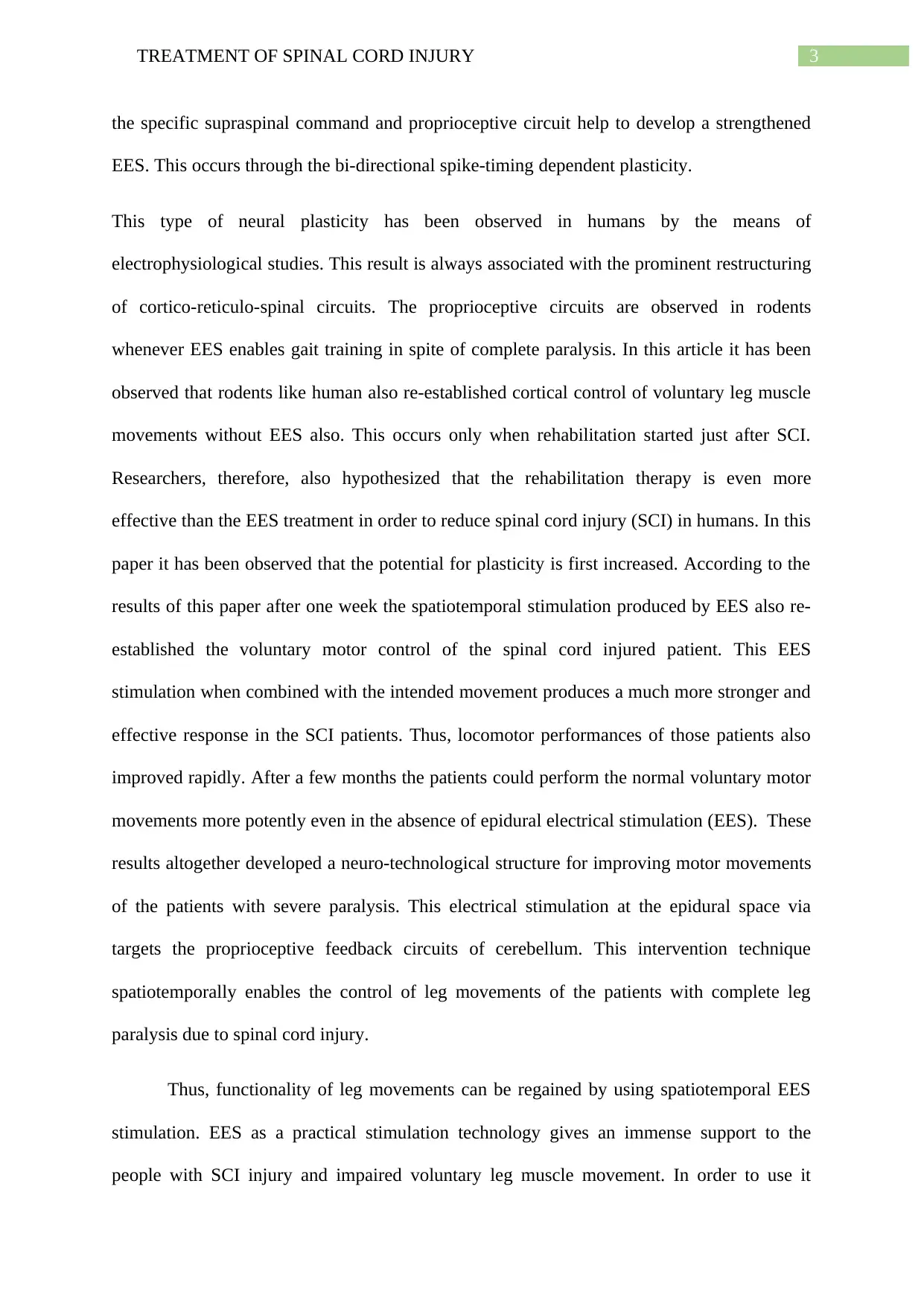
3TREATMENT OF SPINAL CORD INJURY
the specific supraspinal command and proprioceptive circuit help to develop a strengthened
EES. This occurs through the bi-directional spike-timing dependent plasticity.
This type of neural plasticity has been observed in humans by the means of
electrophysiological studies. This result is always associated with the prominent restructuring
of cortico-reticulo-spinal circuits. The proprioceptive circuits are observed in rodents
whenever EES enables gait training in spite of complete paralysis. In this article it has been
observed that rodents like human also re-established cortical control of voluntary leg muscle
movements without EES also. This occurs only when rehabilitation started just after SCI.
Researchers, therefore, also hypothesized that the rehabilitation therapy is even more
effective than the EES treatment in order to reduce spinal cord injury (SCI) in humans. In this
paper it has been observed that the potential for plasticity is first increased. According to the
results of this paper after one week the spatiotemporal stimulation produced by EES also re-
established the voluntary motor control of the spinal cord injured patient. This EES
stimulation when combined with the intended movement produces a much more stronger and
effective response in the SCI patients. Thus, locomotor performances of those patients also
improved rapidly. After a few months the patients could perform the normal voluntary motor
movements more potently even in the absence of epidural electrical stimulation (EES). These
results altogether developed a neuro-technological structure for improving motor movements
of the patients with severe paralysis. This electrical stimulation at the epidural space via
targets the proprioceptive feedback circuits of cerebellum. This intervention technique
spatiotemporally enables the control of leg movements of the patients with complete leg
paralysis due to spinal cord injury.
Thus, functionality of leg movements can be regained by using spatiotemporal EES
stimulation. EES as a practical stimulation technology gives an immense support to the
people with SCI injury and impaired voluntary leg muscle movement. In order to use it
the specific supraspinal command and proprioceptive circuit help to develop a strengthened
EES. This occurs through the bi-directional spike-timing dependent plasticity.
This type of neural plasticity has been observed in humans by the means of
electrophysiological studies. This result is always associated with the prominent restructuring
of cortico-reticulo-spinal circuits. The proprioceptive circuits are observed in rodents
whenever EES enables gait training in spite of complete paralysis. In this article it has been
observed that rodents like human also re-established cortical control of voluntary leg muscle
movements without EES also. This occurs only when rehabilitation started just after SCI.
Researchers, therefore, also hypothesized that the rehabilitation therapy is even more
effective than the EES treatment in order to reduce spinal cord injury (SCI) in humans. In this
paper it has been observed that the potential for plasticity is first increased. According to the
results of this paper after one week the spatiotemporal stimulation produced by EES also re-
established the voluntary motor control of the spinal cord injured patient. This EES
stimulation when combined with the intended movement produces a much more stronger and
effective response in the SCI patients. Thus, locomotor performances of those patients also
improved rapidly. After a few months the patients could perform the normal voluntary motor
movements more potently even in the absence of epidural electrical stimulation (EES). These
results altogether developed a neuro-technological structure for improving motor movements
of the patients with severe paralysis. This electrical stimulation at the epidural space via
targets the proprioceptive feedback circuits of cerebellum. This intervention technique
spatiotemporally enables the control of leg movements of the patients with complete leg
paralysis due to spinal cord injury.
Thus, functionality of leg movements can be regained by using spatiotemporal EES
stimulation. EES as a practical stimulation technology gives an immense support to the
people with SCI injury and impaired voluntary leg muscle movement. In order to use it
Paraphrase This Document
Need a fresh take? Get an instant paraphrase of this document with our AI Paraphraser
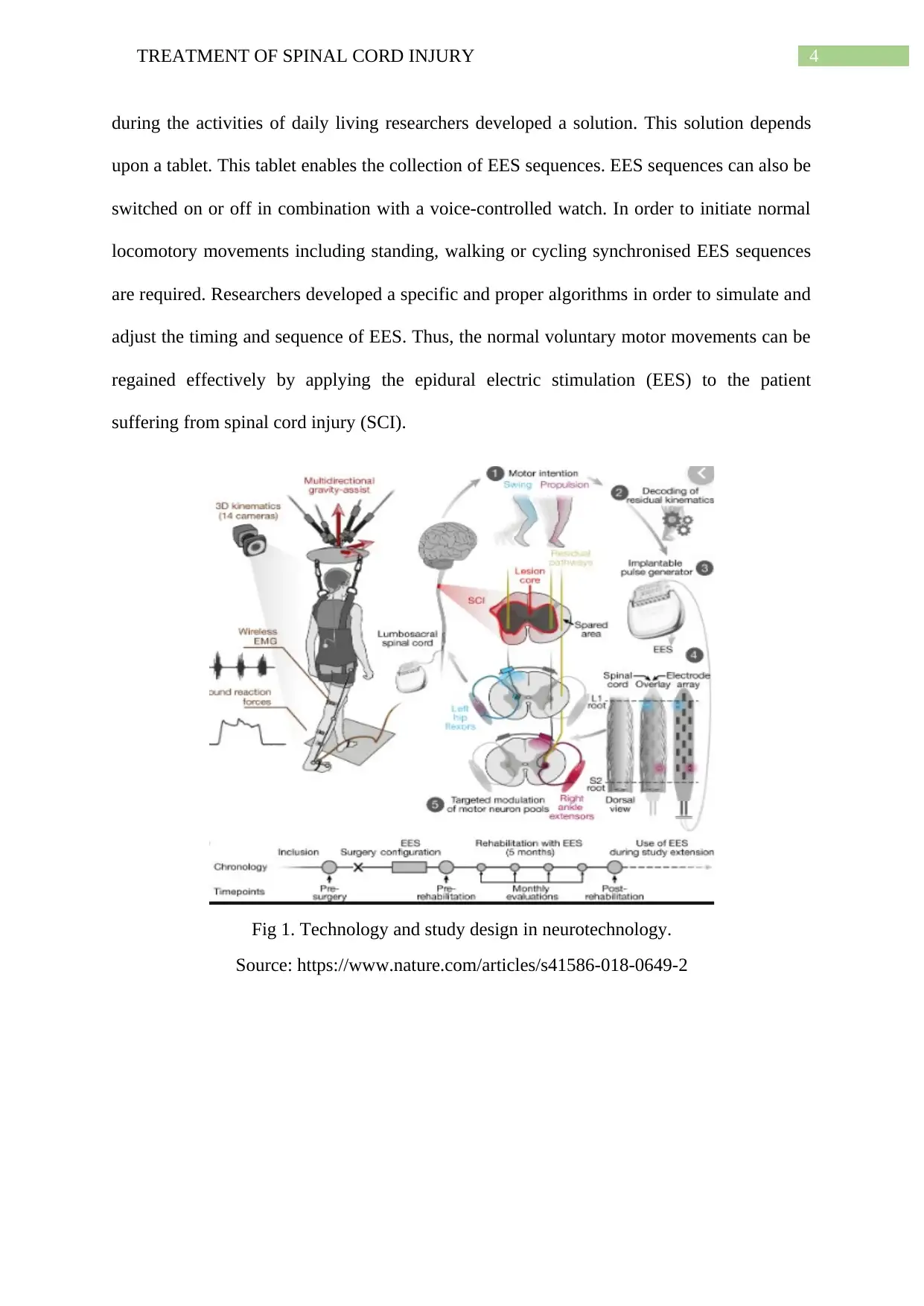
4TREATMENT OF SPINAL CORD INJURY
during the activities of daily living researchers developed a solution. This solution depends
upon a tablet. This tablet enables the collection of EES sequences. EES sequences can also be
switched on or off in combination with a voice-controlled watch. In order to initiate normal
locomotory movements including standing, walking or cycling synchronised EES sequences
are required. Researchers developed a specific and proper algorithms in order to simulate and
adjust the timing and sequence of EES. Thus, the normal voluntary motor movements can be
regained effectively by applying the epidural electric stimulation (EES) to the patient
suffering from spinal cord injury (SCI).
Fig 1. Technology and study design in neurotechnology.
Source: https://www.nature.com/articles/s41586-018-0649-2
during the activities of daily living researchers developed a solution. This solution depends
upon a tablet. This tablet enables the collection of EES sequences. EES sequences can also be
switched on or off in combination with a voice-controlled watch. In order to initiate normal
locomotory movements including standing, walking or cycling synchronised EES sequences
are required. Researchers developed a specific and proper algorithms in order to simulate and
adjust the timing and sequence of EES. Thus, the normal voluntary motor movements can be
regained effectively by applying the epidural electric stimulation (EES) to the patient
suffering from spinal cord injury (SCI).
Fig 1. Technology and study design in neurotechnology.
Source: https://www.nature.com/articles/s41586-018-0649-2

5TREATMENT OF SPINAL CORD INJURY
References
Wagner, F.B., Mignardot, J.B., Le Goff-Mignardot, C.G., Demesmaeker, R., Komi, S.,
Capogrosso, M., Rowald, A., Seáñez, I., Caban, M., Pirondini, E. and Vat, M., 2018.
Targeted neurotechnology restores walking in humans with spinal cord
injury. Nature, 563(7729), p.65.
References
Wagner, F.B., Mignardot, J.B., Le Goff-Mignardot, C.G., Demesmaeker, R., Komi, S.,
Capogrosso, M., Rowald, A., Seáñez, I., Caban, M., Pirondini, E. and Vat, M., 2018.
Targeted neurotechnology restores walking in humans with spinal cord
injury. Nature, 563(7729), p.65.
⊘ This is a preview!⊘
Do you want full access?
Subscribe today to unlock all pages.

Trusted by 1+ million students worldwide
1 out of 6
Your All-in-One AI-Powered Toolkit for Academic Success.
+13062052269
info@desklib.com
Available 24*7 on WhatsApp / Email
![[object Object]](/_next/static/media/star-bottom.7253800d.svg)
Unlock your academic potential
Copyright © 2020–2025 A2Z Services. All Rights Reserved. Developed and managed by ZUCOL.
